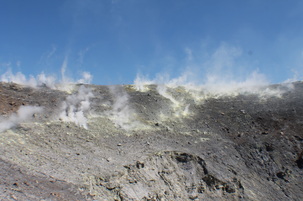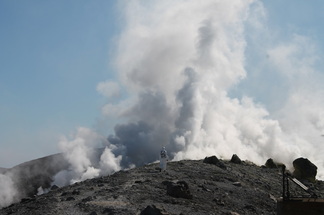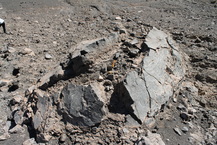 Summit fumaroles at Vulcano Summit fumaroles at Vulcano Vulcano is one of the most fantastic destinations I have had the chance to do fieldwork so far. Combine an easily accessible summit (on the right), persistently active fumaroles and amazing summit views, with great food and the result is a most enjoyable and productive field session. Another great thing about Vulcano as a target for remote sensors like me is that it is relatively accessible all year round (subject to somewhat erratic boat timetables) and it is less subject to inclement weather conditions. This is something that nearby volcanoes Etna and Stromboli suffer from greatly especially during winter months. However, this is certainly not to say that Vulcano doesn't have its challenges when making measurements because it certainly does! For this particular session we were taking a variety of spectroscopic measurements of the summit fumaroles (first photo on the right) using ultra-violet cameras (see Tamburello et al. 2011 for previous measurements at Vulcano) and transecting the fumaroles using a MultiGAS unit (see Aiuppa et al. 2005; Shinohara, 2005). A MultiGAS unit sucks in surrounding air through a tube and analyses for the concentration of a number of volcanic species (e.g. sulphur dioxide, carbon dioxide etc), it can do this at an extremely high resolution of approximately every 2 seconds. To continue with my previous thought, what are these challenges when making measurements? Well first and foremost when using ultra-violet and other spectroscopic systems, for the most accurate of measurements a number of conditions need to be met:
 Transecting the plume. Transecting the plume. To the left is the merged plume of a number of the fumaroles early on one of the mornings. As you can probably observe, the plume is a little too condensed at this stage...but a few hours of waiting and conditions improved to become almost perfect (as above). In the centre of the image you can just about make out a solitary figure clad all in white. This figure is just about to enter the plume and perform a transect of the upper crater terrace fumaroles using a MultiGAS unit. When transecting the plume it is necessary to where goggles and a gas mask to protect against the high concentrations of toxic gases. The first thing you notice when you reach the vicinity of the plume is a faint rotten egg smell (hydrogen sulphide). Anyone who has stood in the vicinity of such gases will know that one of the first noticeable effects, even at relatively low concentrations, is the irritation of respiratory tracts. This can often result in quite a bit of coughing!  A sizable bread crust bomb in the crater. A sizable bread crust bomb in the crater. Of course Vulcano is a great place for more than just the summit fumaroles, previous historical eruptions (e.g. the eruption of 1888) have thrown up some quite spectacularly sized bombs with a large number of them the appropriately named bread-crust bombs which are scattered around the place. After stumbling across a book: Vulcano, Tre Secoli Di Mineralogia (Three centuries of minerals). in a little restaurant called Maurizios (which I highly recommend!), I learnt that there were in fact minute amounts of gold found in the fumaroles of Vulcano. However, don't pack your bags, and shovels yet, the amounts present would certainly not be enough to make you rich very quickly! In the photos at the bottom of the post you can see the plume of Stromboli, taken with a canon 300 mm zoom lens and a couple of the surrounding Aeolian Islands. You can find a few more photos in this section on my website! Comments are closed.
|
Archives
July 2023
|


 RSS Feed
RSS Feed